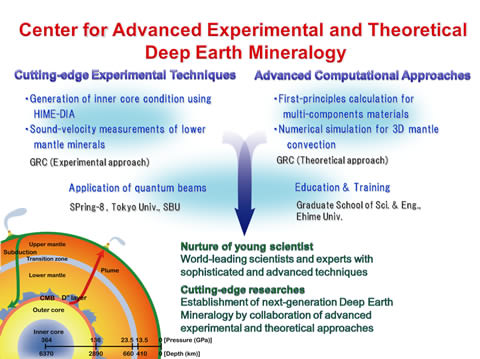HOME > Outline > Objectives
Objectives
The present global COE program under the heading “Center for Advanced Experimental and Theoretical Deep Earth Mineralogy” aims at forming a world class research center in high-pressure mineral physics and related sciences to study Earth's deep interior. To achieve this goal, cutting-edge experimental techniques and advanced computational approaches in the core institute of the Geodynamics Research Center (GRC) at Ehime University will be further developed in cooperation with the tightly allied research groups of the Research and Utilization Division at the Japan Synchrotron Research Institute (JASRI), Geochemical Laboratory at the University of Tokyo, and the Mineral Physics Institute at Stony Brook University (SBU).
Since the GRC was established in 2001, the staff members have made great contributions in developing and improving multi-disciplinary technologies and computational methods relevant to deep Earth mineralogy, in collaboration with the above and other tightly linked research groups. These include the synthesis of new ultrahard nano-polycrystalline diamond (NPD or “Hime-diamond”) and its utilization in high-pressure apparatus, development of techniques for ultrahigh-pressure generation using sintered diamond anvils, ultrasonic measurements combined with synchrotron in situ X-ray observations, first-principles calculations of phase transitions and physical properties, and so on. Based on these advanced technologies and computational approaches, the present program will particularly focus on the following three topics and perform about 10 major research projects relevant to these topics during the period of the COE program:
- Lower Mantle Mineralogy: Mineralogy and composition of the lower mantle
- Core Materials: Phase transitions and melting of iron and related materials under the P,T conditions of the Earth's core
- Deep Earth Water: Behavior of water and hydrogen-bearing substances in the Earth and other planetary deep interiors
Although the number of the faculty members of the GRC is relatively small (9 faculty positions at the time of application), the GRC and other members of Ehime University in the present program have published a number of high-impact papers and are known as the top-ranking research group in Japan in terms of the ISI citation index in Earth sciences. In the present COE program, we are planning to employ about 40 postdoctoral and research fellows in addition to some foreign guest professors and researchers to perform the proposed research projects. Moreover, we will supervise about 20 PhD students during the period of the COE program. Ehime University strongly supports this program and provided special funds for the construction of a new 6000-ton multianvil apparatus and a related building, and for hiking highly-skilled technical staff and special administrative staff members within the fiscal year 2008.
In addition to the proposed projects related to the above topics, we will also perform some interdisciplinary studies, in fields such as materials and physical sciences, utilizing the rich resources of high-pressure apparatus and analytical equipment at the GRC. For this end, some of the materials scientists and solid-state physicists of Ehime University and other institutes, who have been appointed as guest researchers of the GRC will also contribute to this program. Furthermore, we create a new research group tentatively named “Quantum beam mineral physics” at the GRC with the help of the coalition members of JASRI and the University of Tokyo, which would be an important platform for research and education in high-pressure mineral physics and related sciences using synchrotron and neutron beams.
This program covers mineralogy, structure, and dynamics of the Earth's deep interior, particularly focusing on the mineral physics aspects of the lower mantle and the core, based on both experimental and computational methodologies. Ultrahigh-pressure experiments, sound velocity measurements, in situ observations using synchrotron and neutron beams, and first-principles calculations are the core technologies of the present program, and we will develop cutting-edge techniques relevant to these technologies, as well as for the promotion of the sciences on the mineralogy of the lower mantle and the core. Synthesis of new materials at high pressure and their characterization are also covered by the present program, based both on advanced experimental techniques and computational predictions.
Outline



